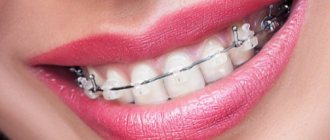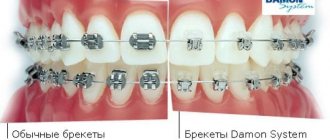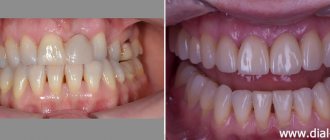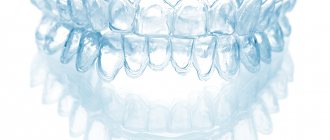If ten years ago someone had told you that wearing a device to correct your bite after forty years was normal, you would hardly have believed him. But today, more and more forty-year-old patients are resorting to such therapy, and one can even say that it has become fashionable.
Perhaps we should thank Madonna, Cindy Crawford, Gwen Stefani and other world-class superstars for this. Celebrities are increasingly appearing in public, proudly flaunting a smile adorned with braces. Some of them consciously prefer devices that attract attention.
Well, long live this fashion, because thanks to it, correcting the bite with braces after forty years is gaining momentum and helps maintain dental health in the second half of life. More and more people of this age can get the smile they have only dreamed of until now.
But the matter, of course, is not only about fashion coming from show business. Today, taking care of your health is a global trend. If earlier an orthodontic structure on the teeth of an adult caused surprise and could become the subject of jokes, today it only says that this person is seriously concerned about his health and image.
There is another important aspect due to which braces are becoming increasingly in demand by people in their fifties. We are talking about the manufacturing technologies of these devices and the process of their installation - they have become much more advanced and comfortable.
Braces today: installed faster, removed earlier
According to orthodontists, patients over the age of forty usually have characteristic doubts regarding treatment. They are concerned:
- how much do braces cost?
- how painful the therapy is;
- how long they will have to wear the braces.
A competent doctor will always try to dispel these doubts. At a consultation with an orthodontist, these doubts are completely dispelled. The doctor will tell you that the braces system causes inconvenience only in the first 2 weeks, until the patient adapts to them, and the treatment time depends on the complexity of the particular case. Today, the most minor problems with bite, such as mild crowding of teeth, can be solved in just 6-8 months. More severe cases may require removal of some molars and treatment for up to 30 months. But still, most often, orthodontic treatment takes 12-24 months, including orthodontic preparation, which is very relevant after 40 years, before rational prosthetics
Reasons to install braces after 40
Braces treatment is an investment in health and beauty. If at a young age the anomaly of malocclusion primarily disturbed the aesthetics of the face, then after 40 (perhaps even earlier) side pathologies appear in the body.
- Problems with diction are getting worse.
- As a result of uneven distribution of load between the dentition, the surface of the teeth is worn down. Defects, chips, and cracks form in the tooth enamel.
- An imbalance in the chewing load leads to inflammatory processes in the gums and carious formations on teeth that work beyond normal limits. The teeth decay and leave the jaw.
- The temporomandibular joint “wears out.” This provokes painful bursts, frequent crunching, clicking, tinkling. As people age, people with malocclusion are more likely to suffer from headaches and joint pain.
- The efficiency of chewing food decreases. Large particles of food are poorly digested and lead to the development of gastrointestinal pathologies.
- Prosthetics in perspective.
The most popular orthodontic systems
The world of orthodontics offers so many options for straightening the teeth that it can be difficult to understand them, but the experienced doctors of the “Full Order” clinic in St. Petersburg will be happy to help each patient make the right choice!
Because of its accuracy and predictability of treatment, patients love the insignia digital braces system. The fact is that such a device is not created on an assembly line, but for each patient individually, with preliminary silicone impressions of the patient’s jaw or digital scanning of the dentition. .
In pursuit of high aesthetics, many patients strive to correct their bite so that neither friends nor work colleagues notice the treatment. In this case, doctors may recommend that they use lingual braces. These brackets are attached to the teeth from the inside, so no one except the orthodontist and his patient will know about their existence.
It is impossible not to mention such traditional metal systems for correcting bites as the famous Daimon braces, which continue to be popular and give excellent results. Thanks to them, patients can forget about those bulky “pieces of iron” that people of past generations wore. Today's fixation techniques, together with the smaller size of the device, do their job: braces look much less bulky and are comfortable to wear.
Until recently, metal braces could only be seen on a child or teenager, and because of this, many adults feel that this device makes them look childish. But just look around and calm down: a huge number of mature people are treated by orthodontists!
It is necessary to say a few words about the Damon clear bracket system, whose advantages are transparency, the absence of ligatures and the good sliding of the arch due to this fact. Thanks to the latest quality, the treatment process is slightly accelerated, and the intervals between necessary visits to the clinic for planned activations increase. In this case, the patient can count on a faster and more convenient solution to his bite problems.
What should you prepare for mentally?
- Patients over 40 do not lack motivation, but they will certainly need patience. To form the correct bite, you will have to move and rotate your teeth, and to do this you will have to find free space in the jawbone. With a long-formed skeletal system, this will not be easy, and you may even have to remove one or two teeth.
- At the preparatory stage, you will have to engage in high-quality sanitation of the oral cavity: cure caries, improve gum health, and, if necessary, perform prosthetics or dental implants.
- Finally, you need to realize that at 40 years old, correction will take several times longer than at 15 years old.
There is no point in regretting that the bite was not corrected in a timely manner during adolescence. Even one and a half to two years will not be wasted. The investment of money and time will fully compensate for straight teeth and the self-confidence acquired with them. In addition, treatment at this age has certain advantages.
Patient reviews about treatment
Patients forty years and older who decided to correct their bite say that in the first days after installing braces, it seemed to them that all the eyes of those around them were focused only on their teeth. But later they noticed that no one paid attention to the orthodontic structure on their teeth, but their attitude towards their appearance changed for the better.
Other patients say they were worried about not being able to eat their favorite foods, but the fears were unfounded. Of course, they had to temporarily stop biting apples, gnawing nuts or enjoying Chinese noodles, which tended to entangle themselves with the installed braces, but in general they did not have to change their diet much.
That is why, with regard to correcting the bite after forty, we can draw the following conclusion: age does not matter when correcting the bite, since it is never too late to start taking care of your health and appearance!
The advantage of interacting with adult patients
Most often, children wear braces solely because of the wishes of their parents. Therefore, it can be quite difficult to convince them of the need for careful, daily care and diet. In addition, at this age there are no necessary self-discipline skills, which can cause many problems. As a result, after removing braces, children are diagnosed with extensive carious lesions or other pathologies, which can be quite difficult to correct even for the most experienced specialist.
Adults approach the issue of correcting their bite much more responsibly; they follow all the recommendations of their treating doctor. Most people over 40 are completely financially independent, so they can afford to install the most aesthetically attractive and comfortable structures made of ceramics or sapphire.
Such patients are mentally prepared for the upcoming difficulties and really want to achieve an excellent result. Adults are sincerely grateful to doctors who help them get a perfect smile.
previous post
Pain from braces
next entry
How long should adults wear braces?
It is impossible to answer this question unambiguously: maybe one year, or maybe several years. Bite correction in adult patients is a long, labor-intensive process that requires patience and discipline. Therefore, orthodontists rarely persuade adults to straighten their teeth. If a person himself does not want this, then nothing will force him to conscientiously fulfill all the doctor’s demands. When treating adults with orthodontics, it is important that the dentist find a compromise between what he wants to achieve and what the patient wants to achieve. Orthodontists, of course, always strive to restore the perfectly aligned position of teeth, no matter how long it takes - at least three years, at least five years. The patient may get tired of the treatment and abandon it. The dentist’s main task is to honestly tell you how long the treatment will take and how it will proceed. And then hear whether the patient is ready to go this route.
Reaching a new goal
Perhaps you are faced with a difficult choice: on the one hand, you are embarrassed about your smile, on the other, you do not want to wear braces for 1 to 3 years. But the faster you start, the faster you finish. As they say, the best time to do this is yesterday, the second best time is today. Moreover, you will experience great joy as you systematically move towards your goal, seeing how your teeth are straightened month after month, and in the end you will get the long-awaited result - a beautiful smile. This experience will certainly be useful in other areas of life.
Retainers: why are they worn after braces are removed?
A retainer is a device that looks like an arch. It is placed on the back surface of the teeth when braces are removed. This way the new position of the teeth is secured. The ligamentous apparatus of the teeth has muscle memory, so no matter how we move the teeth, they will tend to return to their “original” position. Wearing a retainer is an essential part of orthodontic treatment. This is especially true for people over twenty-five years of age. A retainer is installed for at least two periods of wearing braces: for example, the patient wore them for one year, then the retainer will need to be worn for two years. Foreign orthodontists generally argue that you need to wear retainers constantly - this is the only way to guarantee that your teeth will remain straight. In general, after some time the retainer can be replaced with a night guard or plate. But some kind of structure supporting the new position of the teeth will definitely be needed - this is a classic. Unfortunately, patients often neglect this stage of treatment, experience relapses and begin to talk about the ineffectiveness and uselessness of orthodontic treatment in adulthood.
Which braces are better to choose?
The choice of system for a person aged between 40 and 50 years depends on the type and severity of the pathology. In severe cases, there is only one option - metal braces. They can also be recommended to those who are determined to get quick results and are not embarrassed by iron braces in their mouth. An additional advantage of metal braces is their affordable price, especially when it comes to a ligature-free system.
A ligature (from the Latin ligare - binding) is a wire or rubber ring that connects the power arc with each bracket part. Ligatures hold the archwire in the bracket grooves and prevent it from moving. However, they quickly become unusable, stretch, stain and therefore need regular replacement. This increases the treatment period and obliges the patient to visit the orthodontist once every month or month and a half.
Non-ligating (self-ligating) structures have become a breakthrough in orthodontic treatment: the braces in them are attached to the arch with snap-clips that are not subject to deformation and staining.
Due to the absence of ligatures, the friction force in the grooves is minimal, and the teeth do not have to overcome unnecessary resistance. The advantage of self-ligating braces is aesthetics. The system is not overloaded with details, due to which the smile is significantly “lightened”.
Attractive in appearance, but fragile and capricious - this is about ceramic and sapphire braces. Such systems are hardly noticeable on the teeth and are comfortable to wear, but are less effective and more expensive compared to metal ones.
Important!
For public and shy people, the doctor may recommend lingual braces, which are attached to the inside of the teeth.
Braces cause allergies
There are very few contraindications to braces. Mainly these are dental, neurological and joint diseases. A tendency to an allergic reaction is not a limitation to orthodontic treatment. If a patient is allergic to any material (for example, metal), then a brace system is selected for him, the elements of which are made of a different material. Modern designs can be made individually and have hypoallergenic properties.
There is no need to be afraid of treating malocclusion with braces. The orthodontic design copes even with serious dental defects. All myths about braces are relics of the past, guesswork or unsuccessful treatment experiences from unqualified doctors. A decisive step towards correcting your bite with braces is a step towards a healthy and beautiful smile.
Read also
How to place veneers
The installation of veneers is performed for the purpose of aesthetic restoration of the dentition.
Who is an orthopedic dentist?
Orthopedics in dentistry is a branch of medicine that deals with the restoration of teeth using all modern prosthetic techniques.
Maximum age limit
The formed bone tissue of an adult is difficult to mechanically influence, so the corrective process takes longer than in children. Often you even have to remove one element to make room for the rest to move.
No doctor will tell you the exact age after which braces cannot be installed. The possibility of correcting pathologies using brace systems is determined individually depending on the following factors:
- anatomical features of the dentofacial apparatus;
- condition of bone tissue;
- health of the body as a whole.
Features of the action of orthodontic structures
The topic of aligners or braces - which is better - is discussed on forums. Patients talk about their impressions, and doctors explain how both designs work. In braces, a metal arch with a memory effect gradually returns the teeth to a physiologically justified position, restrains jaw growth or, conversely, stimulates it. Visits to the orthodontist are needed to change the tension of the arch.
The good thing about aligners is that they can be used by children as young as 6 years old.
, whose permanent teeth have not yet grown. Correcting a child’s bite with aligners can only be entrusted to a highly qualified orthodontist dentist with extensive clinical experience. An accurate prognosis is important - templates are made for the entire course at once; at the very beginning of treatment, the doctor writes out the algorithm using a specialized computer program.
Contraindications for occlusion adjustment in adults
Unfortunately, not all patients who need to correct jaw anomalies can have braces. There are absolute and temporary contraindications.
Absolute:
- installed implants;
- lack of teeth;
- endocrine diseases;
- mental illness;
- pathology of bone tissue;
- oncology;
- blood diseases.
Temporary:
- acute infections;
- presence of dental diseases;
- enamel damage;
- poor hygiene (stones, plaque);
- bruxism;
- pregnancy.











